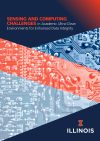Defence and Security Experts Nick Newman and Chris Cole of global innovation and transformation consultancy PA Consulting, discuss how online safety has taken a hit amidst the COVID-19 pandemic and how to work together to end the sexual exploitation of children online
One of the less well-publicised (but not unexpected) consequences of the COVID-19 lockdown has been a disturbing rise in reports of online child sexual exploitation and abuse (OCSEA). Thames Valley Police has reported a 146% increase in child sex abuse reports compared with the same period in 2019; and a BBC report has highlighted how the lockdown has led to a global slowdown in the removal of internet child abuse images, as technology firms have fewer staff available to delete illegal material.
The scale of this insidious modern cybercrime was already vast and expanding rapidly. For the past two years, PA Consulting has worked with the WePROTECT Global Alliance to produce the first two Global Threat Assessments (2018 and 2019) (2). These assessments show the real scale of the harm:
- 18.4 million referrals of child sexual abuse material by technology companies to the U.S. National Center for Missing and Exploited Children in 2018.
- 94% of child sexual abuse material found online by the Internet Watch Foundation (IWF) contains images of children aged 13 or under – 39% were under ten years old.
- 46 million unique images or videos relating to child sexual abuse material in EUROPOL’s repository.
- 750,000 individuals estimated to be looking to connect with children across the globe for sexual purposes online at any one time.The 2019 Global Threat Assessment, published at the fourth WePROTECT international summit in Ethiopia, last December, highlighted three significant trends.
Stark differences between the Global North and South are a growing problem
As the scale and pace of internet use grow, we are experiencing a widening gap between those nations who have had the time to develop sophisticated support services and those who are achieving technology parity so fast their protective measures cannot keep up.
In the 12 months to January 2019, it is estimated that over 367 million new internet users came online, with the majority from countries in the Global South. There have been two major catalysts for this growth. Firstly, 4G and 5G cellular networks have been rapidly rolled out across Africa, Asia, and Latin America. Furthermore, mobile device ownership has grown exponentially, with cheap and reliable second-hand devices now accessible to low-income consumers in developing countries.
It would be a grave mistake to dismiss this trend as ‘someone else’s problem’ because online child sexual exploitation and abuse are not confined within geographical boundaries. Foreign users are exploiting sexual images and videos of British children, just as British offenders are paying to live stream ‘on-demand’ abuse of children from poorer countries.
An immediate and urgent challenge is to help developing nations accelerate their online education and safeguarding arrangements, digital policing, and regulatory responses.
Offenders’ technology usage creates complex challenges for law enforcement
Whilst offenders are increasingly using Dark Web networks to share images, tips and techniques for grooming children and evading detection, the vast majority of referrals are for images that can be easily found on freely accessible websites, social media and messaging services. These platforms remain the most common methods for meeting and grooming children online. However, the technology is evolving fast and a new wave of offenders is being enabled by highly secure, encrypted, and anonymised messaging apps, that are now widely available as mainstream consumer services.
In 2018, two-thirds of the 18.4 million worldwide reports of child sexual abuse material came from mes- saging services. These reports will not be possible if end-to-end encryption is implemented by default.
Senior ministers from the Five Country Ministerial Group (3) have stressed that law enforcement agencies’ efforts to investigate and prosecute the most serious crimes would be hampered by end-to-end encryption and urged the industry not to develop their systems and services in ways that empower criminals.
Children’s online exposure amplifies vulnerability
Children’s exposure to harm is amplified by owning smartphones at younger ages. This is compounded by changing social attitudes towards image sharing and risky online behaviour. In the first half of 2019, the IWF dealt with 22,484 reports of self-generated indecent imagery – one-third of all the reports they actioned in this period. Of these, 96% featured girls, of whom 85% were aged under 13.
This increases the volume of material available to offenders, and children’s vulnerability to exploitation and abuse by adults, as well as cyberbullying by other children.
Opportunity from complexity?
This convergence of expanding internet access, offend- ers’ use of secure, anonymised services and children’s increased online exposure is expanding the potential for harm. This threatens to overwhelm international law enforcement agencies. However, events like the
WePROTECT Global Summits are helping to raise awareness and understanding amongst international leaders. It also provides a platform to share cross- sectoral approaches that enable nations to align their collective efforts through a 26-point Global Strategic Response (4). The Voluntary Principles to Counter OCSEA, (5), recently launched by the ‘Five Country’ Ministerial Group, with the backing of several of the world’s major technology companies, also highlight the significant international collaboration already under- way. And the UK is at the forefront of international moves to implement comprehensive regulation of online service providers to protect the vulnerable from the full spectrum of online harms.
While the scale of this problem is vast, the WePROTECT Global Alliance is making progress in building a world where there is no place for children to be exploited or abused online.
References
1. https://www.paconsulting.com/insights/2019/protecting-our-children/ The WePROTECT Global Alliance is an international movement dedicated to national and global action to end the sexual exploitation of children online. Its membership currently consists of 97 countries, 27 global technology companies, 30 leading non-governmental organisations and eight regional organisations.
2. https://www.paconsulting.com/insights/2019/weprotect-global-threat-assessment/
Australia, Canada, New Zealand, United Kingdom, United States.
3. https://www.gov.uk/government/publications/five-country-ministerial-communique
4. https://static1.squarespace.com/static/5630f48de4b00a75476ecf0a /t/5deeccd9ab886c6b1e41cf9b/1575931097730/FINAL+- +Global+Strategic+Response+.pdf
5. https://www.gov.uk/government/publications/voluntary-principles-to- counter-online-child-sexual-exploitation-and-abuse
Contributor Profile
Contributor Profile
Editor's Recommended Articles
-
Must Read >> Pornhub: The ongoing revenge porn investigation
































